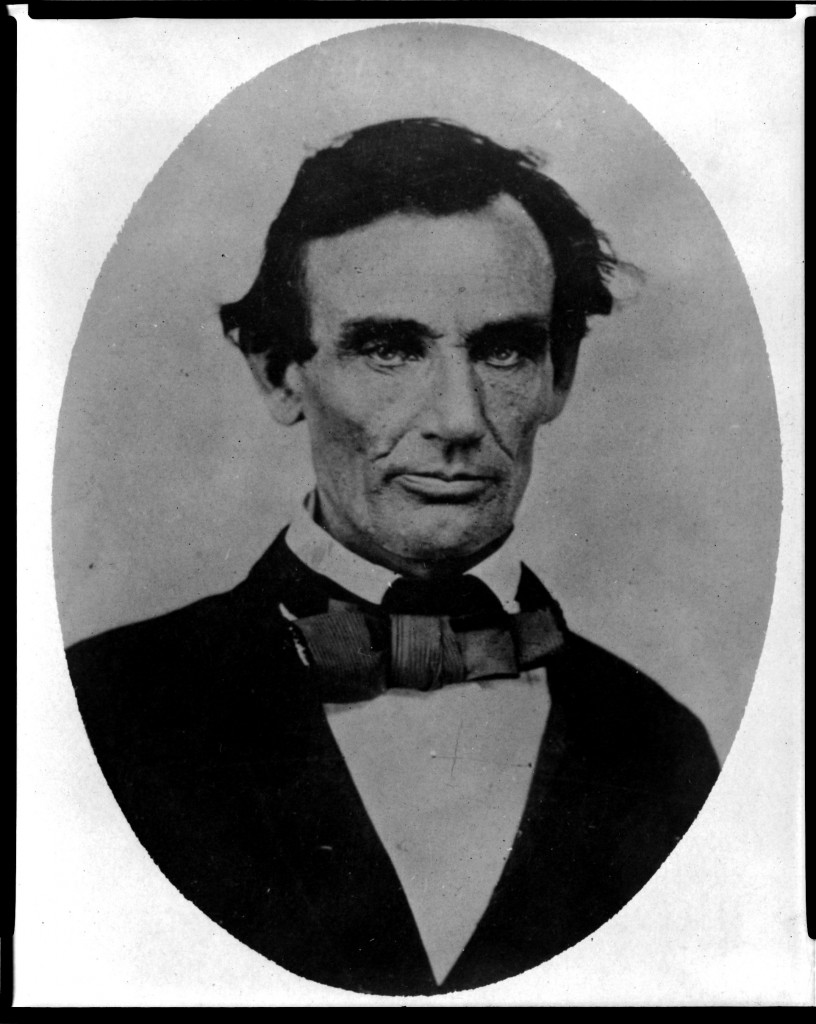What to do an entry on this week? Choosing the next Pope is still very much in the news, but I already did an entry on that. The Oscars are tonight, but I already did an entry on that. Some parts of the country are getting tons of snow (though maybe not record levels), a few people are still wondering why snow storms suddenly have names, while windy March is right around the corner.
I wanted to do an entry on pajamas because I really like them and a nice, fuzzy, flannel topic like that might be just the thing right now, but I already did an entry on those, too. So what's an Apple Lady to investigate?
We recently celebrated Presidents' Day and I've already done an entry about George Washington, but I haven't done an entry about Abraham Lincoln. Since I am willing to bet $5,000 that Lincoln wins Best Picture (even though I haven't seen any of the nominees), I think an entry about Abraham Lincoln is in order.

Abraham Lincoln, wondering what the next Daily Apple topic will be
(Image from ancestry.com's rootsweb)
Since we Americans start learning about Lincoln in grade school, I'm going to try to find some little-known facts--or at least things I never knew before.

Abraham Lincoln didn't have a beard until after he became president. Here he is in 1858.
(Photo from The American Civil War at 150)

The Lincoln Bedroom, where Lincoln never slept, in 2007.
(Photo from the White House Museum)

Lincoln and General McClellan at Antietam. His coat is looking a bit snug. Looks like he's got a bunch of official documents in his inside pocket.
(Photo from Kiko's House)

He's aged a ton here, hasn't he?
(Photo from Entrepreneur)

The 13th Amendment states simply: "Section 1. Neither slavery nor involuntary servitude, except as a punishment for crime whereof the party shall have been duly convicted, shall exist within the United States, or any place subject to their jurisdiction. Section 2. Congress shall have power to enforce this article by appropriate legislation."
(Image from the Library of Congress; see a larger version here)

An artist's rendition of the shooting. After he was shot, he was taken to a house nearby. The bed was too short for his tall frame, so he was laid on it diagonally and the footboard was removed.
(Photo from Abraham Lincoln Classroom. Details of his treatment post-shooting from Gizmodo)
The chair he sat in at the theatre, his shawl, and his hat are pictured here.
(That photo is (c) Abraham Lincoln Online)

I wanted to do an entry on pajamas because I really like them and a nice, fuzzy, flannel topic like that might be just the thing right now, but I already did an entry on those, too. So what's an Apple Lady to investigate?
We recently celebrated Presidents' Day and I've already done an entry about George Washington, but I haven't done an entry about Abraham Lincoln. Since I am willing to bet $5,000 that Lincoln wins Best Picture (even though I haven't seen any of the nominees), I think an entry about Abraham Lincoln is in order.

Abraham Lincoln, wondering what the next Daily Apple topic will be
(Image from ancestry.com's rootsweb)
Since we Americans start learning about Lincoln in grade school, I'm going to try to find some little-known facts--or at least things I never knew before.
Dates
- Born February 12, 1809
- Died April 15, 1865
- President of the United States 1861-1865
Personal Life
- We've all heard of that log cabin in Illinois, but Lincoln was actually born in Kentucky.
- When he was 8, his family moved to Indiana, and they were essentially squatters, farming the land until his father could afford to buy it.
- His mother died when he was 9, and he was largely raised by his step-mother, whom he liked. He also had three step-siblings.
- It wasn't until he was 21 that his family moved to Illinois.
- Worked for a time as a pilot on a flatboat down the Mississippi to New Orleans.
- While he was a Christian, he was never affiliated with any church.
- He was the first President to wear a beard. (OK, I knew this, but it is kind of surprising when you think of all that facial hair in presidential portraits.)

Abraham Lincoln didn't have a beard until after he became president. Here he is in 1858.
(Photo from The American Civil War at 150)
- In 1849, he patented a system to combine buoyancy chambers in steamboats. He is so far the only President to hold a patent.
- He had pet dogs, cats, horses, and a pet turkey.
- The horse he had when he died was named Old Bob and was part of his funeral procession.
- His love of horses persisted in spite of having been kicked in the head and knocked unconscious by one at the age of 10. He had been shouting at the horse, "Git up, you old hussy," when he got kicked. Except he only got as far as "Git up" when the horse kicked him. According to biographer Carl Sandburg, when he came to, he finished his sentence and the first words out of his mouth were ". . . you old hussy."
- He and his wife, Mary Todd, had four children, three of whom died. The only child who lived longer than age 18 was Robert Todd.
- He was pretty good at wrestling. He lost only one match out of 300.
- He never actually slept in the Lincoln Bedroom. While he was president, he used that room as his personal office and meeting-room.

The Lincoln Bedroom, where Lincoln never slept, in 2007.
(Photo from the White House Museum)
Political
- He served one term in the US House of Representatives as a member of the Whig party -- the only Whig representing Illinois -- and he spoke out against the Mexican-American War.
- After he left the House, he served as a company attorney and lobbyist for the Illinois Central Railroad.
- He ran for US Senate twice and was defeated both times.
- It was the passage of the Kansas-Nebraska Act, which allowed states to choose whether they would be slave states or free states, that brought about the formation of the Republican Party. It grew out of the Whig party and coalesced around people who agreed that slavery should not be allowed to expand westward. Lincoln, a moderate opposed to slavery, left the Whigs and joined the Republicans.
- He was elected President in 1860, and Civil War broke out less than a year later. (OK, I knew this one too, but it's still stunning. Can you imagine, being President for a few months, and then the country splits and starts a war with itself? I would probably soil my undergarments.)
- Lincoln, however, took action right away. This is from Biography.com:
He distributed $2,000,000 from the Treasury for war materiel without an appropriation from Congress; he called for 75,000 volunteers into military service without a declaration of war; and he suspended the writ of habeas corpus, arresting and imprisoning suspected Confederate sympathizers without a warrant. . . . From all directions, Lincoln faced disparagement and defiance. He was often at odds with his generals, his Cabinet, his party, and a majority of the American people.

Lincoln and General McClellan at Antietam. His coat is looking a bit snug. Looks like he's got a bunch of official documents in his inside pocket.
(Photo from Kiko's House)
- Meanwhile, as the Civil War was going on, he accomplished a few other things, too.
- In 1862, he established the US Dept of Agriculture, made it possible for land-grant colleges in states across the US to be formed, he signed the Homestead Act, and the Pacific Railroad Act.
- In 1863, he signed the National Banking Act, which created a national banking system and established our first paper currency.
- He also declared Thanksgiving a national holiday.
- There was also that little thing called the Emancipation Proclamation that he issued in January 1863. It actually didn't have much legal oomph, but it set the stage for the 13th Amendment.

He's aged a ton here, hasn't he?
(Photo from Entrepreneur)

The 13th Amendment states simply: "Section 1. Neither slavery nor involuntary servitude, except as a punishment for crime whereof the party shall have been duly convicted, shall exist within the United States, or any place subject to their jurisdiction. Section 2. Congress shall have power to enforce this article by appropriate legislation."
(Image from the Library of Congress; see a larger version here)
- Contrary to popular belief, Lincoln did not write the Gettysburg Address on a scrap of paper while riding the train on the way there. He began crafting it weeks before on White House stationery. The bunk about the scrap of paper appeared in highly fictionalized article in Scribner's, which was later expanded into a book. A bunky book, you might say.
- The day he was shot, April 14, 1865, was Good Friday.

An artist's rendition of the shooting. After he was shot, he was taken to a house nearby. The bed was too short for his tall frame, so he was laid on it diagonally and the footboard was removed.
(Photo from Abraham Lincoln Classroom. Details of his treatment post-shooting from Gizmodo)
The chair he sat in at the theatre, his shawl, and his hat are pictured here.
(That photo is (c) Abraham Lincoln Online)
- The very day he was assassinated, he signed into law a bill that created the Secret Service. But since the Secret Service's original purpose was to combat widespread counterfeiting and not to protect the President, it wouldn't have done him any good.
- It was, in fact, counterfeiters who tried to steal his corpse from his tomb in 1876. They planned to hold his corpse for ransom in exchange for the release of a top counterfeiter from prison. The Secret Service foiled their plot, however. After that, his body was moved to an unmarked grave and later encased in a steel cage and buried under 10 feet of concrete.
- He hated to be called "Abe."

Another young Abraham Lincoln
(Photo from Old Time Radio Catalog)
I've read that the movie deals almost entirely with efforts to pass and ratify the 13th Amendment. So here's one last little fact for you about good old #13:
For some factual deviations in the movie, see The Daily Beast,
P.S. OK, so I guessed wrong. Good thing I never actually bet that $5,000. But he did win Best Actor. And by "he," I kind of mean Lincoln, as much as Daniel Day Lewis.
Sources
A Lincoln Library, Facts about Abraham Lincoln
Biography.com, Abraham Lincoln
Northern Illinois University Lincoln/Net, Abraham Lincoln Fast Facts
History.com, 10 Things You May Not Know About Abraham Lincoln
Chicago Tribune, 10 things you might not know about Abraham Lincoln
The White House, 16. Abraham Lincoln
National Park Service, Lincoln Home, Lincoln Facts
NPR, Getting The 13th Amendment Passed In Miss., Just A Little Late, February 23, 2013
I've read that the movie deals almost entirely with efforts to pass and ratify the 13th Amendment. So here's one last little fact for you about good old #13:
- The last state to ratify was Mississippi in 1995, and technically, it wasn't even done then because they never submitted the proper paperwork to the National Archives. Thanks to the help of an interested lay-historian, the 13th Amendment was finally and officially ratified in Mississippi, the last state of the union to do so, in 2013.
For some factual deviations in the movie, see The Daily Beast,
P.S. OK, so I guessed wrong. Good thing I never actually bet that $5,000. But he did win Best Actor. And by "he," I kind of mean Lincoln, as much as Daniel Day Lewis.
Sources
A Lincoln Library, Facts about Abraham Lincoln
Biography.com, Abraham Lincoln
Northern Illinois University Lincoln/Net, Abraham Lincoln Fast Facts
History.com, 10 Things You May Not Know About Abraham Lincoln
Chicago Tribune, 10 things you might not know about Abraham Lincoln
The White House, 16. Abraham Lincoln
National Park Service, Lincoln Home, Lincoln Facts
NPR, Getting The 13th Amendment Passed In Miss., Just A Little Late, February 23, 2013


























